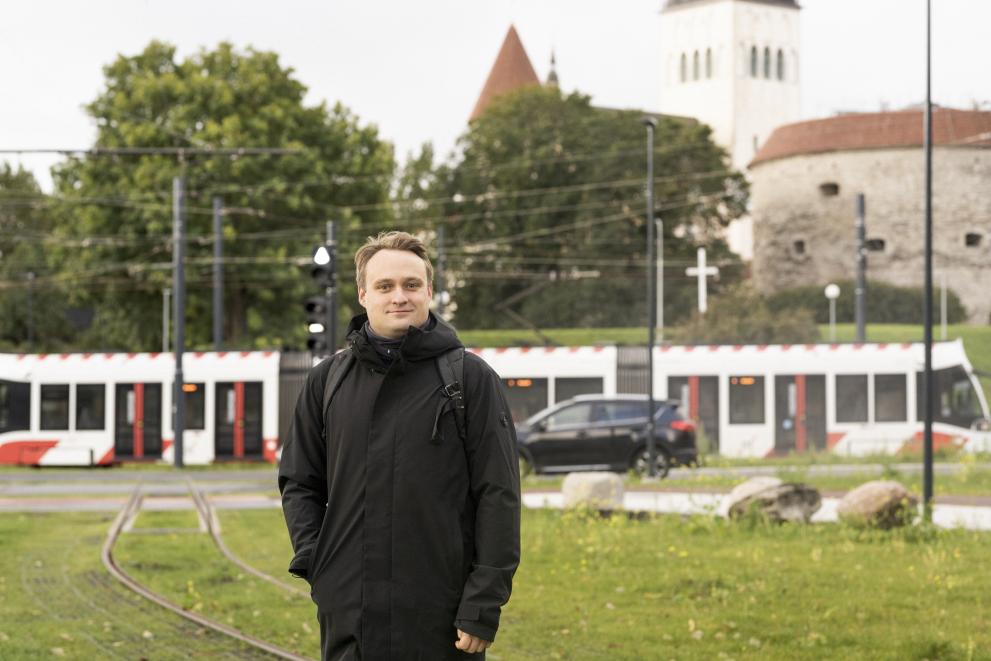
L'Estonia è un paese di notevoli ambizioni. Lo dimostrano chiaramente le riforme e gli investimenti previsti dal piano per la ripresa e la resilienza (PRR) del paese, che destina finanziamenti per 953 000 000 di euro nel quadro di NextGenerationEU a una serie di iniziative ambiziose. Tra le priorità del paese vi è la transizione verso l'energia pulita, che implica la diversificazione dell'approvvigionamento energetico, investimenti nelle rinnovabili e l'eliminazione graduale di fonti inquinanti come lo scisto bituminoso. Nel passaggio dell'Estonia verso una maggiore sostenibilità, anche la mobilità pulita ha assunto un ruolo centrale, come dimostra la linea tranviaria del Vanasadam, porto antico di Tallinn.
La nuova linea rappresenta infatti uno dei progetti infrastrutturali faro del piano: un tratto di 2,5 km di metropolitana leggera, entrato in servizio nel dicembre 2024 e realizzato con un investimento da 36 500 000 di euro nel quadro di NextGenerationEU. Per molti nella capitale si tratta di un progetto atteso da tempo, che collega finalmente il porto antico – e con esso i collegamenti marittimi verso altri paesi nordici – al nodo Rail Baltica nel centro della città, alla stazione ferroviaria regionale e all'aeroporto di Tallinn. Uno degli obiettivi del progetto è ridurre il traffico e l'inquinamento atmosferico in città, offrendo un'alternativa di trasporto più sostenibile e contribuendo così a migliorare la qualità di vita dei residenti.
Per saperne di più, ne abbiamo parlato con l'urbanista e architetto Jaak-Adam Looveer e con il residente e pendolare Kaur Orgusaar:
La nuova linea tranviaria rappresenta un'aggiunta positiva per Tallinn?
J-AL: A dir poco! Grazie alla linea tranviaria del porto antico disponiamo ora di un corridoio di trasporto pienamente integrato che apre un mondo di possibilità: i finanziamenti dell'UE sono stati fondamentali. La nuova linea ha migliorato l'interconnessione dei trasporti all'interno della nostra città. Il porto antico offre collegamenti marittimi con altre destinazioni nordiche, in particolare Helsinki, e la nuova linea tranviaria collega quest'area al terminal Ülemiste della Rail Baltica, che acquisirà sempre più importanza con l'avanzare di questo mega progetto. Collega inoltre il porto antico al centro città, alla stazione ferroviaria centrale e all'aeroporto, il che lo rende un pilastro fondamentale del sistema infrastrutturale di Tallinn.
KO: Per me, che risiedo a Tallinn, si tratta di una vera svolta. I benefici per la città sono enormi. Abito in centro e prima mi era complicato raggiungere il porto, e persino l'aeroporto, perché non esisteva una linea tranviaria diretta. Grazie a questa nuova linea posso arrivarci comodamente e senza difficoltà. Viaggio abbastanza per lavoro e quindi per me è veramente un grande vantaggio. Se devo prendere un aereo o un traghetto, ora posso farlo senza problemi. In generale, il tram riduce anche la necessità di usare l'automobile e dovrebbe incoraggiare un maggior numero di residenti a scegliere i mezzi pubblici. Questo contribuirà sicuramente a ridurre il traffico.
"Disponiamo ora di un corridoio di trasporto pienamente integrato che apre un mondo di possibilità: i finanziamenti dell'UE sono stati fondamentali".
– Jaak-Adam Looveer, urbanista e architetto
Avrà un impatto positivo dal punto di vista ambientale?
J-AL: Sicuramente. Come ha detto Kaur, la nuova linea è anche un modo per incentivare l'uso dei mezzi pubblici. Quando i collegamenti di una città sono disarticolati, come lo sono stati finora, diventa difficile sfruttarli appieno. Un residente che in autobus o in tram non riesce a spostarsi da una zona e all'altra in tempi ragionevoli è più incline a utilizzare l'automobile. Questo è stato un problema per Tallinn, con conseguenze negative in termini di traffico, inquinamento atmosferico e anche vivibilità. Le città con reti di trasporto più integrate se la cavano meglio da questo punto di vista, in quanto permettono di ridurre l'inquinamento acustico e atmosferico e la riduzione del numero di automobili e ingorghi incide positivamente sulla salute pubblica.
KO: Non posso che essere d'accordo. Pur non essendo un esperto di questioni ambientali, è positivo vedere Tallinn muoversi nella stessa direzione di altre capitali europee. Sviluppare i trasporti pubblici e promuovere uno stile di vita senza auto in città è un vantaggio per tutti. Lo considero un passo verso un futuro più rispettoso dell'ambiente e una qualità di vita migliore per coloro che vivono in città. A giovarne è anche l'immagine di Tallinn, che si dimostra moderna e al passo con i tempi. Per quanto riguarda l'espansione urbana, credo che questa linea contribuirà anche a rilanciare la zona del porto antico come area residenziale. Fino ad ora, infatti, era rimasta un po' troppo isolata per essere attrattiva.
"Per me, che risiedo a Tallinn, si tratta di una vera svolta. I benefici per la città sono enormi".
— Kaur Orgusaar, residente e pendolare a Tallinn
Forse non sorprende che il piano per la ripresa e la resilienza (PRR) dell'Estonia riservi particolare attenzione alla sostenibilità e alla transizione verso l'energia pulita. Insieme ai finanziamenti assegnati nell'ambito del piano REPowerEU, NextGenerationEU sostiene il paese baltico nella riduzione della dipendenza dalle fonti energetiche tradizionali e nella transizione verso le rinnovabili. Sebbene il legame possa sembrare labile, la linea tranviaria del Vanasadam, porto antico di Tallinn, segue una logica simile: migliora l'attuale sistema di trasporto urbano, in modo da offrire ai cittadini una vita migliore e più sostenibile. Si tratta solo di un tassello all'interno di un mosaico più ampio, che riflette l'immagine di un paese che progredisce a buon ritmo.
Dettagli
- Data di pubblicazione
- 20 maggio 2025
- Autore
- Direzione generale della Comunicazione
- Location
- Estonia
